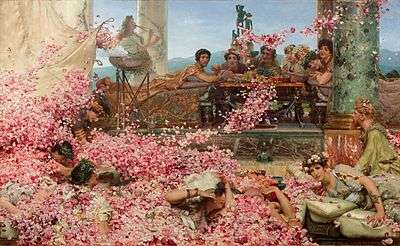The Roses of Heliogabalus

The Roses of Heliogabalus is an 1888 painting by the Anglo-Dutch artist Sir Lawrence Alma-Tadema. It is currently owned by the Spanish-Mexican billionaire businessman and art collector Juan Antonio Pérez Simón.[1][2][3]
Theme
The painting measures 132.7 × 214.4 centimetres (52.2 × 84.4 in). It shows a group of Roman diners at a banquet, being swamped by drifts of pink rose petals falling from a false ceiling above. The Roman emperor Elagabalus reclines on a platform behind them, wearing a golden robe and a tiara, watching the spectacle with other garlanded guests. A woman plays the double pipes beside a marble pillar in the background, wearing the leopard skin of a maenad, with a bronze statue of Dionysus, based on the Ludovisi Dionysus, in front of a view of distant hills.
The painting depicts a (probably invented) episode in the life of the Roman emperor Elagabalus, also known as Heliogabalus, (204–222), taken from the Augustan History. Although the Latin refers to "violets and other flowers", Alma-Tadema depicts Elagabalus smothering his unsuspecting guests with rose petals released from a false ceiling. The original reference is this:
- Oppressit in tricliniis versatilibus parasitos suos violis et floribus, sic ut animam aliqui efflaverint, cum erepere ad summum non possent.[4]
- In a banqueting-room with a reversible ceiling he once buried his parasites in violets and other flowers, so that some were actually smothered to death, being unable to crawl out to the top.[5]
In his notes to the Augustan History, Thayer notes that "Nero did this also (Suetonius, Nero, xxxi), and a similar ceiling in the house of Trimalchio is described in Petronius, Sat., lx." (Satyricon).[6]
History
The painting was commissioned by Sir John Aird, 1st Baronet for £4,000 in 1888. As roses were out of season in the UK, Alma-Tadema is reputed to have had rose petals sent from the south of France each week during the four months in which it was painted.[7]
The painting was exhibited at the Royal Academy summer exhibition in 1888. Aird died 1911, and the painting was inherited by his son Sir John Richard Aird, 2nd Baronet. After Alma-Tadema also died 1912, the painting was exhibited at a memorial exhibition at the Royal Academy in 1913, the last time it was seen at a public exhibition in the UK until 2014.
Alma-Tadema's reputation declined markedly in the decades after his death. Following the death of the 2nd Baronet in 1934, the painting was sold by his son, the 3rd Baronet, in 1935 for 483 guineas. It failed to sell at Christie's in 1960, and was "bought in" by the auction house for 100 guineas.
Eventually, it was acquired by Allen Funt: he was the producer of Candid Camera, and a collector of Alma-Tadema's at a time when the artist remained very unfashionable. The painting was included in an exhibition at the Metropolitan Museum of Art in New York in March and April 1973.[8] After Funt experienced financial troubles, he sold the painting along with the rest of his collection at Sotheby's in London in November 1973, achieving a price of £28,000. The painting was sold again by American collector Frederick Koch at Christie's in London in June 1993 for £1,500,000.[9][10]
The painting is part of a private collection but was on display from 14 November 2014 to 29 March 2015 at the Leighton House Museum in London as part of the exhibition, A Victorian Obsession: The Pérez Simón collection at Leighton House Museum, the first time since Alma-Tadema's memorial exhibition at the Royal Academy in 1913 that it has been exhibited in London.[11]
References
- ↑ Kennedy, Maev (2 June 2014). "Quiet billionaire's Victorian art collection loaned to Leighton House". The Guardian. Retrieved 14 February 2015.
- ↑ Kennedy, Maev (13 November 2014). "Victorian art 'comes home' to London house". The Guardian. Retrieved 14 February 2015.
- ↑ Bugler, Caroline (13 November 2014). "Lord Leighton RA and the Victorian ideal of female beauty: Objects of desire". London: Royal Academy of Arts. Retrieved 14 February 2015.
- ↑ "Historia Augusta • Vita Heliogabali (Pars II)".
- ↑ "Historia Augusta • Life of Elagabalus (Part 2 of 2)".
- ↑ "Historia Augusta • Life of Elagabalus (Part 2 of 2)".
- ↑ From ‘Riches to Rags to Riches’, ArtNews, 1 January 2011
- ↑ Exhibition of Paintings by Sir Lawrence Alma-Tadema Opens at Metropolitan Museum, press release, March 1973
- ↑ A Victorian Obsession: The Pérez Simón Collection’ at the Leighton House Museum, Financial Times, 14 November 2014
- ↑ A Moral Critique of The Roses of Heliogabalus, Frederick W. Farrar, VictorianWeb
- ↑ "A Victorian Obsession: The Pérez Simón collection at Leighton House Museum". London: Royal Borough of Kensington and Chelsea. Retrieved 14 February 2015.
